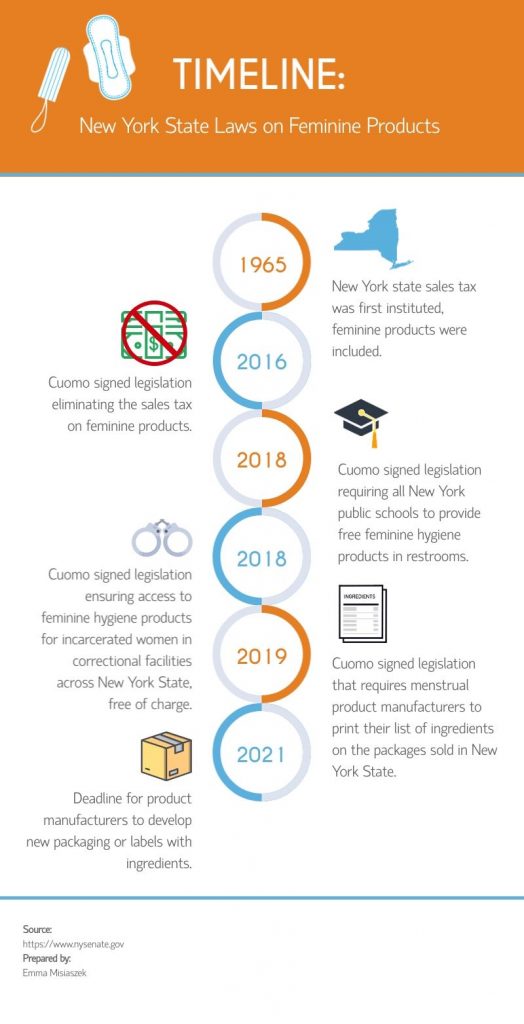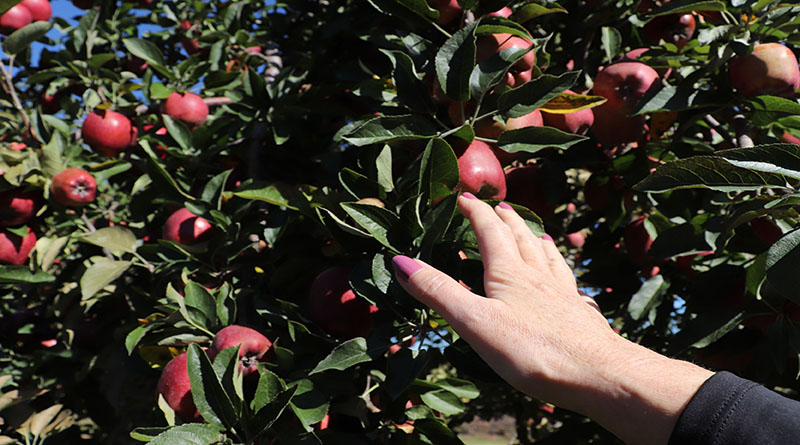By Jennifer Bianco
Republished with permission from The Legislative Gazette
Do you know what’s in your tampons and pads? If not, soon you will, thanks to Gov. Andrew Cuomo’s new law that requires menstrual product manufacturers to print their list of ingredients on the packages sold in New York State.
On Friday, October 11, 2019, known internationally as the “Day of the Girl,” Cuomo signed the bill which makes New York the first state in the United States to require such ingredient labels on their products.
Sen. Roxanne Persaud, D-Canarsie, sponsored the bill saying, “We know what’s in the food we eat, the medicine we take, and the clothes we wear. We have a right to know what’s in our menstrual products.”
Tampons, pads and other menstrual products are a multi-billion dollar industry. However, these products are often marketed and sold with little to no information about the ingredients they contain and if they are safe.
Products may contain toxic and allergenic chemicals that can cause significant health concerns. Labeling feminine hygiene product packages would allow consumers to make informed decisions regarding the purchase of these products.
“It seems logical considering the personal nature of menstrual products that we require manufacturers to disclose the ingredients in the products that are widely used by women in the most intimate part of their bodies,” Persaud said. “Consumers deserve transparency when shopping for any product.”
On Friday, New York became the first state in the nation to require labeling of period products.
“Practically every product on the market today is required to list its ingredients, yet these items have inexplicably evaded this basic consumer protection,” Cuomo said. “It’s part of the pervasive culture of inequality in our society that has gone on for too long, and that injustice ends today as we become the first state in the nation to mandate ingredient disclosure and empower women to make their own decisions about what goes into their bodies.”
In 2016, Cuomo signed legislation eliminating the sales tax on feminine products. In 2018, he signed legislation requiring all public schools to provide free feminine hygiene products in restrooms, as well as providing free feminine hygiene products to women in state and local correctional facilities.
“This first-in-the-nation disclosure law firmly establishes New York as a national leader on menstrual equity. Menstrual product ingredient disclosure is a vital consumer empowerment tool, and will hold menstrual product manufacturers to the highest level of accountability,” said Assembly sponsor, Linda Rosenthal, D-Upper West Side.
Poor menstrual hygiene can lead to physical health risks, including reproductive and urinary tract infections.
Kathleen Curtis, executive director of Clean and Healthy New York, said, “Clean and Healthy New York’s work is focused on peoples’ right to know about toxicants in their daily lives, and the need for swift, comprehensive government and corporate action when harm could occur. We deserve to know what ingredients we’re putting in and on our bodies. Thanks to this critical piece of legislation, we finally will.”
The Food and Drug Administration considers feminine products to be “medical devices” and therefore not subject to ingredient labeling. Because of this, the ingredients used in these products are rarely publicly disclosed.
Reports on the ingredients found in many different brands have shown the presence of known reproductive toxins such as carbon disulfide and methylene chloride. Nanosilver, which is effective at killing bacteria but can also be a potentially harmful substance, is found in some pads and period underwear. Vaginal administration of nanosilver can lead to the migration of silver particles into the bloodstream. The use of nanosilver and other added chemicals in period products is increasing and people aren’t aware of what they are being exposed to.
Further, the percentage of organic to synthetic materials in menstrual hygiene products often fluctuates with changes in the price of cotton, and consumers are not informed of these changes in product composition.
“This law makes sure that people are informed about the ingredients in the products that they need to manage their period,” said Amber Garcia, executive director of Women’s Voices for the Earth. “It builds on [our] work to ensure that people can see what is in their products and that toxic chemicals are not present in the products that we all use in our everyday lives. No one should have to worry that their period products will cause harm to their health or future fertility.”
Product manufacturers will have 18 months to develop new packaging or labels with ingredients. The new law will require every package of menstrual products to display a list of all intentionally added ingredients on the outside of the package so consumers can inspect the list at the point of sale.

